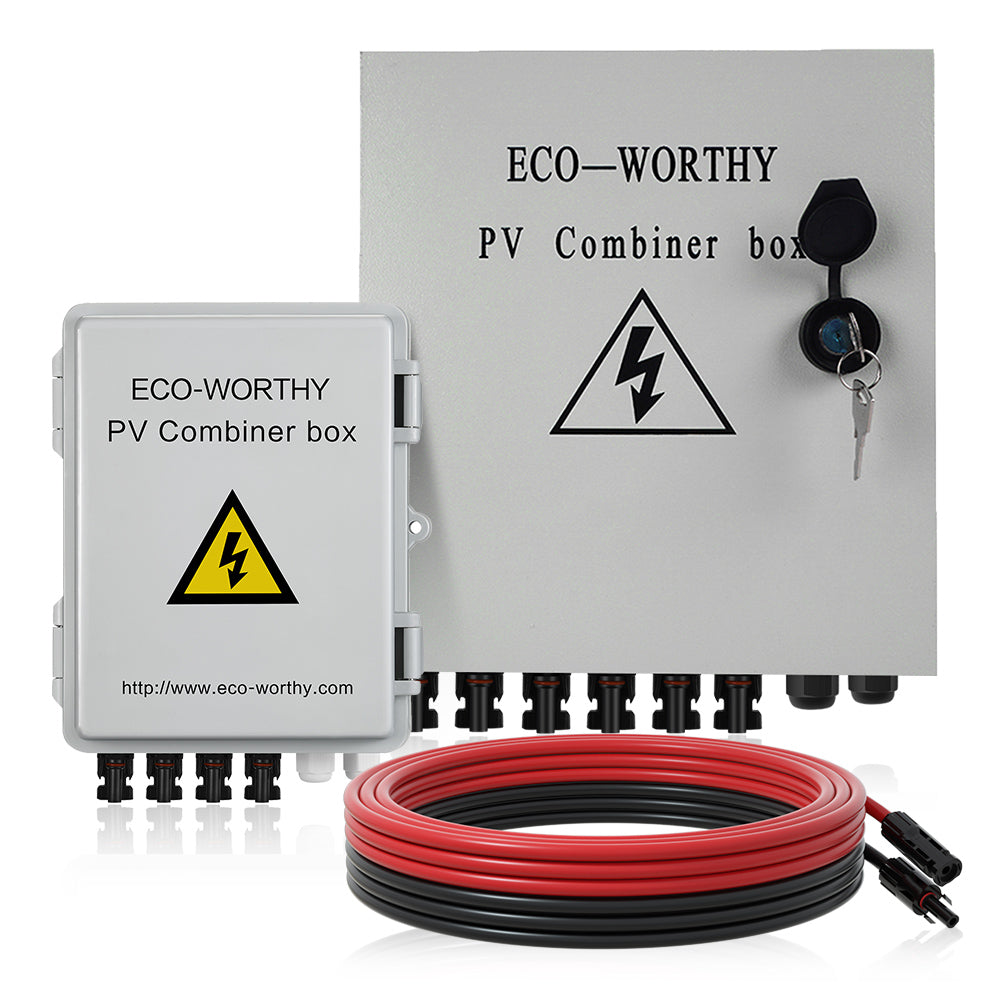Battery storage is becoming an increasingly popular addition to solar energy systems. Two of the most common battery chemistry types are lithium-ion and lead acid. When people choose the battery, one question that often comes up is‘what is the difference between lead acid and lithium, and when should each battery type be used?’Therefore, this article is aim at pointing out the differences between lithium battery and lead acid battery.

Here are the top 4 differences between the two batteries.
Cost:
The cost is usually the subject at the forefront of everyone’s minds. As is often the case, it is not a simple answer and cost effectiveness is really dependent on the needs of your application. Lead acid is great fit for large scale stationary applications where space is abundant and energy requirements are low.
However, when you start looking at price in terms of the power or range, lithium ion technology can often be a more favorable option, because the lifetime value of a lithium battery evens the scales. They offer a much longer lifespan and far greater usable capacity than lead-acid batteries. A single lithium battery lasts 10 times longer than its lead-acid counterpart on average. The cost of lithium-ion batteries over time can be a lot cheaper than lead-acid.
Calculated by cycle life, or how many times a battery can be discharged and then recharged before it got to be replaced, lithium-ion batteries offer a 3000-5000 cycle life when discharged up to 80 percent. Flooded lead-acid and VRLA batteries, on the other hand, only offer around a 400 to 500 cycle life when discharged up to 80 percent. If you cycled your lithium battery once a day, it would offer more than 10 years of life, while a standard lead-acid battery often lasts less than two years. Lithium batteries have an estimated project cost of $469 per kWh, compared to $549 per kWh for lead-acid.
Capacity:
Most lads often fail to factor in is that you have to buy many more lead-acid batteries - sometimes double, triple, or quadruple as many - just to reach the same usable capacity as far fewer lithium batteries. This is because they only look at the total rated or nameplate capacity of a battery (i.e., the kWh the battery is theoretically able to store) rather than the usable capacity (i.e., the kWh the battery is able to store after factoring in depth of discharge, efficiency and charge/discharge rate restrictions).
A battery’s capacity is a measure of how much energy can be stored (and eventually discharged) by the battery. While capacity numbers vary between battery models and manufacturers, lithium battery technology has been well-proven to have a significantly higher energy density than lead acid batteries. This means that more energy can be stored in a lithium battery using the same physical space. Because you can store more energy with lithium technology, you can discharge more energy, thus power more appliances for longer periods of time.
Just like solar panel efficiency, battery efficiency is an important metric to consider when comparing different options. Most lithium batteries are 95 percent efficient or more, meaning that 95 percent or more of the energy stored in a lithium battery is actually able to be used. Conversely, lead acid batteries see efficiencies closer to 80 to 85 percent. Higher efficiency batteries charge faster, and similarly to the depth of discharge, improved efficiency means a higher effective battery capacity.

When determining what capacity of battery to use for a system, a critical consideration for lead acid is how long the system will take to discharge. The shorter the discharge period, the less capacity is available from the lead acid battery. A 100Ah lead acid battery will only deliver 80Ah if discharged over a four hour period. In contrast, a 100Ah lithium battery system will achieve over 98Ah even during a 30 minute discharge.
High temperature performance:
In hot climates where the average temperature is 33°C, the disparity between lithium and lead acid is further exacerbated. The cycle life for lead acid drops to 50% of its moderate climate rating while lithium will remain stable until temperatures routinely exceed 49°C.

Analyses indicate that lithium has an 18% higher lifetime cost when compared to lead acid in moderate climates, but is much more cost effective in hot climates. There is a significant area of the world that sees average temperatures high enough to decrease the life of lead acid batteries. A factor not represented in the figure is that the battery systems are often housed in enclosures that see internal temperatures 10°C higher than the air temperature due to solar insolation, which would further decrease the performance of lead acid. The average temperature is also not completely representative of how much time is spent at extreme temperatures where the degradation accelerates in lead acid systems (e.g. the lead acid battery will be spent one hour at 40°C and one hour spent at 20°C has a worse impact on the battery compared to two hours spend at 30°C)
Lifespan:
Batteries are also similar to air conditioner in that they degrade over time and become less effective as their age. Discharging a battery to power your home or appliances and then recharging it with solar energy or the grid counts as one “cycle”. The numbers vary from study to study, but lithium batteries generally last for several times the number of cycles as lead acid batteries, leading to a longer effective lifespan for lithium products, which is about THREE THOUSAND TIMES.

Other things you could distinguish them
Constant Power

Lithium battery delivers the same amount of power throughout the entire discharge cycle, while an SLA battery output strong power at the beginning, but gets gradually decreased.
The result of this difference would be as, you turned on a flashlight and notice it's dimmer than the last time you use it. It's because the inside battery is about to get empty, but not totally out yet, it provides a little remaining power, which is not sufficient to completely lighten the bulb.
But if there is a lithium battery inside instead of the SLA, the bulb would be as bright as the beginning till the end of the discharging, and when the power gets run out, the light will directly turn off, without a previous dim signal.
Cold Temperature Performance
Using battery in cold weather would cause significant capacity reduction due to chemistries features. So there are two things you need to consider when evaluating a battery for cold temperature use:
Charging and Discharging
Lithium battery does not accept low-temperature charging (Below 32°F / 0°C). On the contrary, an SLA battery can allow a low current charge in cold.
On the other hand, a lithium battery has a higher discharge capacity at cold temperatures compared with SLA. At 0°F / -17°C, lithium is discharged 70% of its rated capacity, but SLA could just deliver 40%.

Tip: Since the lithium battery could be used in cold, if it has just finished the discharging, the battery will have generated enough heat to get a charge. So before it has a chance to cool down, the charging is practical.
Maintenance
Lithium battery should not be stored at 100% capacity, while the SLA needs to. It's because SLA battery self-discharge rate is 5 times or even greater than that of a lithium one. Actually, many customers use a trickle charger to constantly keep the battery at 100% so that the battery life will not decrease due to dry storage.
Series & Parallel Wiring
One important precaution: When connecting batteries together in series or parallel, it's crucial that make sure all factors of them matched, including capacity, voltage, resistance, state of charge(present voltage), and chemistry of course.
Lead Acid and Lithium batteries can not be used together in the same string.
SLA battery can handle more quantity to be wired in a string than lithium battery, especially when put in series, it's because Lead Acid battery does not contain the BMS, which has a circuit board protecting the battery, that board has a limitation of string voltage, the limitation for a 4 lithium batteries string in series should be 51.2v.
There are advantages of LiFePO4 batteries in addition to the above differences:
SAFER:
1) Inherently safer chemistry. They are developed with a strong safety profile. They are powerful Phosphate-based batteries that provide super thermal and chemical stability, which is able to offer an increase in safety over other kinds of lithium batteries that are produced with other cathode materials. It is safer and more reliable.
2) It won’t explode in regular conditions. We have done many tests includes short circuit, puncture, impact, water immersion situations, the Eco Worthy lithium battery won’t explode nor catch a fire.
3) It’s NO gasses emitted. According to the U.S. government, lithium ion batteries aren't an environmental hazard. "LiFePO4 batteries are classified by the federal government as non-hazardous waste and are safe for disposal in the normal municipal waste stream."
BMS:
The BMS inside provides extra protection. A “balancing” process to make sure all the cells in a battery bank are equally charged is automatically achieved by the BMS (Battery Management System). Just charge you battery and you are good to go. The BMS protects the battery cells during performance and from damage preventing potential faults from occurring. A quality BMS system will disconnect loads if the voltage gets too low and disconnect chargers if the voltage gets too high. Because being over voltage for a prolonged period during charging can cause plating of the metallic lithium on the battery’s anode which permanently degrades performance.

EASIER USING:
Lead-acid batteries are very heavy. Weight can be a severe drawback for mobile applications. They also do not store significant amounts of power for their size. Their weight means that to hold enough power for a household’s use would take up a lot of space. How much they store per weight and space is called their energy density, which is relatively low as far as batteries go.
On the contrary, LiFePO4 battery is lightweight and portable, which is 50-60% lighter than lead-acid equivalent, so you can take anywhere you as you like. For example, a 100ah lead acid battery is 29.12kg while a 100ah lithium battery weighs 10.4kg.

It's essential to install the lead acid battery in a straight up position to prevent issue with venting, throught the SLA is designed to not leak, the vents still may lead some gasses release.
Lithium battery is in a diverse design, especially the LiFePO4 battery, the cells inside are individually selead and will not leak. This lead to no restriction in the installation direction of a lithium battery. It's practical to put it upside down, or on its side.

With the proper volume and high power density, Lithium batteries can be suitable for litlle-size applications such as outdoor emergency power supplies, toy cars, scooters, etc.

MORE EFFICIENT and STABLE:
The cycle life is about up to 10X longer than lead acid batteries; it’s low self-discharge so the battery maintains state of charge; 25-50% more capacity than lead-acid equivalent; it is 2.5X more efficient operation at low temperatures. Safely operational up to 149°F (65°C ); full power available throughout discharge. The voltage will not drop like lead-acid ones.
In addition, Lithium battery has a very low self-discharge rate, compared to other kinds of batteries, normally about 2-3% loss of the power per month when you just put it away. While the lead acid battery has about 5-10% loss past each month.
Bottom Line
Lead acid and lithium offer pros and cons for the stationary energy storage industry. When calculating the balance of the pros and cons for a specific application, many factors must be considered. The importance of initial cost, lifetime, weight, volume, temperature sensitivity, maintenance access and access to product all play a role in battery selection.
There is currently no single solution that is better than another for all situations, but lithium systems offer better cost of ownership in a number of situations, specifically hot climates, despite the higher initial cost.















